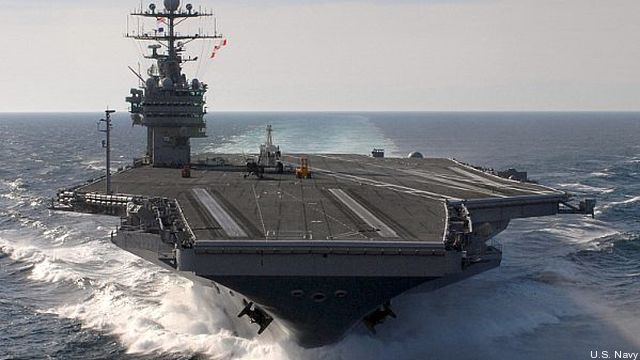
WASHINGTON: Despite reports of its possible demise, the Navy’s new aircraft carrier has been spared the budget ax. Now Pentagon and service officials have to figure out how they will pay for it.
The White House’s Office of Management and Budget approved the Navy’s request to include the carrier program in its six-year spending plan, according to the OMB memo approving the Pentagon’s budget request for 2013. Earlier this year, former Chairman of the Joint Chiefs of Staff Gen. James Cartwright said the department was debating whether to cancel the carrier program. Top service leaders, including former Chief of Naval Operations Adm. Gary Roughead, responded by arguing repeatedly the Ford-class carrier will be instrumental in projecting U.S. naval power across the globe.
While the White House approved the carrier program, the OMB memo raises a number of questions about how long the Navy will take to pay for it. OMB outlined a number of options.
One would be to extend the Navy’s original financing plan by two years. Instead of spreading the cost of the first Ford-class ship over 10 years the Navy may get 12 years to do it. The original eight-year plan was initially stretched out to 10 in fiscal 2010. The two additional years could significantly reduce how much the Navy will have to pay each year to finance that first carrier, CVN-79. “The Navy would initiate the four-year construction process in FY15 after 8 years of advance procurement activities,” the OMB pass back memo says.
The plan would basically allow the Navy to buy one aircraft carrier every seven years, compared to one carrier every five years under the current plan. That schedule is one the Navy included in earlier versions of its FY-13 budget blueprint. This new plan would help the Navy avoid a cut to the service’s 11-carrier force, sources say.
Another option may be to forgo the two-year extension and let the Navy begin building the CVN-79 in fiscal 2013. “The CVN-79 funding profile does not change, and because construction belongs in FY-13, there is no need for additional advance construction,” the memo says. Whichever option the Navy ends up going with, OMB recommended the service go back to the original eight-year funding plan for the second carrier, CVN-80.
Major trends and takeaways from the Defense Department’s Unfunded Priority Lists
Mark Cancian and Chris Park of CSIS break down what is in this year’s unfunded priority lists and what they say about the state of the US military.


























